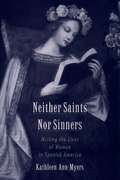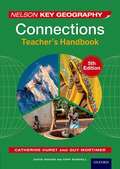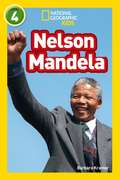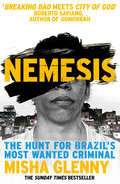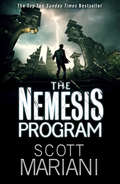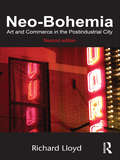- Table View
- List View
Neither Man nor Beast: Feminism and the Defense of Animals (Bloomsbury Revelations)
by Carol J. AdamsIn this landmark work of animal rights activism, Carol J. Adams - the bestselling author of The Sexual Politics of Meat - explores the intersections and common causes of feminism and the defense of animals. Neither Man Nor Beast explores the common link between cultural attitudes to women and animals in modern Western culture that have enabled the systematic exploitation of both. A vivid work that takes in environmental ethics, theological perspectives and feminist theory, the Bloomsbury Revelations edition includes a new foreword by the author and new images illustrating the continuing relevance of the book today.
Neither Nowt Nor Summat: In search of the meaning of Yorkshire
by Ian McMillanI’m going to define the essence of this sprawling place as best I can. I’m going to start here, in this village, and radiate out like a ripple in a pond. I don’t want to go to the obvious places, either; I want to be like a bus driver on my first morning on the job, getting gloriously lost, turning up where I shouldn’t. I’m going to confirm or deny the clichés, holding them up to see where the light gets in. Yorkshire people are tight. Yorkshire people are arrogant. Yorkshire people eat a Yorkshire pudding before every meal. Yorkshire people solder a t’ before every word they use... If there were such a thing as a professional Yorkshireman, Ian McMillan would be it. He’s regularly consulted as a home-grown expert, and southerners comment archly on his ‘fruity Yorkshire brogue’. But he has been keeping a secret. His dad was from Lanarkshire, Scotland, making him, as he puts it, only ‘half tyke’. So Ian is worried; is he Yorkshire enough?To try to understand what this means Ian embarks on a journey around the county, starting in the village has lived in his entire life. With contributions from the Cudworth Probus Club, a kazoo playing train guard, Mad Geoff the barber and four Saddleworth council workers looking for a mattress, Ian tries to discover what lies at the heart of Britain’s most distinct county and its people, as well as finding out whether the Yorkshire Pudding is worthy of becoming a UNESCO Intangible Heritage Site, if Harrogate is really, really, in Yorkshire and, of course, who knocks up the knocker up?
Neither Saints Nor Sinners: Writing the Lives of Women in Spanish America
by Kathleen Ann MyersThis book brings together the portraits and autobiographical texts of six 17th-century Latin American women, drawing on primary sources that include Inquisition and canonization records, confessional and mystic journals, and legal defenses and petitions.
Neither Slave nor Free: The Freedman of African Descent in the Slave Societies of the New World (The Johns Hopkins Symposia in Comparative History #3)
by David W. Cohen Jack P. Greene"The ten essays deal with colonial Spanish America, Surinam and Curacao, colonial Brazil, the French Antilles, Saint Domingue, Jamaica, Barbados, the North American slave states, Cuba, and nineteenth-century Brazil.... One also gets a strong sense from these papers of the rich variation within each society.... An important book."—Journal of Southern History"A distinctive contribution to the enticing but treacherous domain of comparative history. It succeeds because it is written by qualified scholars who address a delimited, manageable subject.... The task was to canvass current knowledge and pinpoint areas of needed research regarding two topics: first, the experience of the free colored as a measure of the character of slavery and race relations; second, the fundamental roles of this group in the evolution of the respective societies."—American Historical Review
Neither Slave nor Free: The Freedman of African Descent in the Slave Societies of the New World (The Johns Hopkins Symposia in Comparative History #3)
by David W. Cohen; Jack P. Greene"The ten essays deal with colonial Spanish America, Surinam and Curacao, colonial Brazil, the French Antilles, Saint Domingue, Jamaica, Barbados, the North American slave states, Cuba, and nineteenth-century Brazil.... One also gets a strong sense from these papers of the rich variation within each society.... An important book."—Journal of Southern History"A distinctive contribution to the enticing but treacherous domain of comparative history. It succeeds because it is written by qualified scholars who address a delimited, manageable subject.... The task was to canvass current knowledge and pinpoint areas of needed research regarding two topics: first, the experience of the free colored as a measure of the character of slavery and race relations; second, the fundamental roles of this group in the evolution of the respective societies."—American Historical Review
Neither use nor ornament: A cultural biography of clutter and procrastination
by Tracey PottsNeither use nor ornament is a book about personal productivity, narrated from the perspective of its obstacles: clutter and procrastination. It offers a challenge to the self-help promise of a clutter-free life, lived in a permanent state of efficiency and flow. The book reveals how contemporary projections of the good, productive life rely on images of failure. Riffing on the aphorism ‘less is more’ – a dominant refrain in present day productivity advice – it tells stories about streamlining, efficiency and tidiness over a time period of around 100 years.By focusing on the shadows of productivity advice, Neither use nor ornament seeks to unravel the moral narratives that hold individuals to account for their inefficiencies and muddles.
Neither use nor ornament: A cultural biography of clutter and procrastination
by Tracey PottsNeither use nor ornament is a book about personal productivity, narrated from the perspective of its obstacles: clutter and procrastination. It offers a challenge to the self-help promise of a clutter-free life, lived in a permanent state of efficiency and flow. The book reveals how contemporary projections of the good, productive life rely on images of failure. Riffing on the aphorism ‘less is more’ – a dominant refrain in present day productivity advice – it tells stories about streamlining, efficiency and tidiness over a time period of around 100 years.By focusing on the shadows of productivity advice, Neither use nor ornament seeks to unravel the moral narratives that hold individuals to account for their inefficiencies and muddles.
Nelson Key Geography Connections Teacher's Handbook
by David Waugh Tony Bushell Guy Mortimer Catherine HurstThis Teacher's Handbook offers a page of at-a-glance support for each spread in the 5th edition of Nelson Key Geography Connections. Designed to be flexible and easily integrated, it works alongside the Student Book to help deliver exciting, relevant and up-to-date lessons that engage all of your students.
Nelson Mandela: Level 4 (National Geographic Readers Ser.)
by Barbara Kramer National Geographic KidsNational Geographic Primary Readers is a high-interest series of beginning reading books that have been developed in consultation with education experts. The books pair magnificent National Geographic photographs with lively text by skilled children’s book authors across four reading levels. Nelson Mandela, who courageously dealt with adversity and emerged a world leader, has been an inspirational role model for millions of people around the world, from students to presidents. After being imprisoned for 27 years, in 1994 he became South Africa's first democratically-elected president and shared the Nobel Peace Prize. Learn all about his life, especially the challenges he faced and how he persevered, in this thoughtful biography. Level 4: Independent reader: Perfect for kids who are reading on their own with ease and are ready for more challenging vocabulary with varied sentence structures. They are ideal for readers of White and Lime books
Nelson Mandela (large print)
by RnibThis image shows a portrait of Nelson Mandela. There is a locator dot shown, which will be at the top left of the page when the image is the correct way up. The image is surrounded by an image border. He is facing you so all facial features can be found. Only his head, neck and some of his shoulders are shown. At the top of the image is his curly hair which is going grey. He has two distinctive creases on his forehead. His eyes are nearly closed as they are crinkled as he smiles. He has a broad smile with noticeable cheek creases from the smile. He wears a dark grey suit jacket, white shirt and a dark blue tie. He has a slightly wrinkled face with a skin colour of golden brown.
Nelson Mandela (UEB contracted)
by RnibThis image shows a portrait of Nelson Mandela. There is a locator dot shown, which will be at the top left of the page when the image is the correct way up. The image is surrounded by an image border. He is facing you so all facial features can be found. Only his head, neck and some of his shoulders are shown. At the top of the image is his curly hair which is going grey. He has two distinctive creases on his forehead. His eyes are nearly closed as they are crinkled as he smiles. He has a broad smile with noticeable cheek creases from the smile. He wears a dark grey suit jacket, white shirt and a dark blue tie. He has a slightly wrinkled face with a skin colour of golden brown.
Nelson Mandela (UEB uncontracted)
by RnibThis image shows a portrait of Nelson Mandela. There is a locator dot shown, which will be at the top left of the page when the image is the correct way up. The image is surrounded by an image border. He is facing you so all facial features can be found. Only his head, neck and some of his shoulders are shown. At the top of the image is his curly hair which is going grey. He has two distinctive creases on his forehead. His eyes are nearly closed as they are crinkled as he smiles. He has a broad smile with noticeable cheek creases from the smile. He wears a dark grey suit jacket, white shirt and a dark blue tie. He has a slightly wrinkled face with a skin colour of golden brown.
Nemesis: One Man and the Battle for Rio
by Misha Glenny'Breaking Bad meets City of God' Roberto Saviano, author of GomorrahHUSBAND. This is the story of an ordinary man who became the king of the largest slum in Rio, the head of a drug cartel and Brazil’s most notorious criminal. FATHER. A man who tried to bring welfare and justice to a playground of gang culture and destitution, while everyone around him drew guns and partied. DRUG LORD. It’s a story of gold-hunters and evangelical pastors, bent police and rich-kid addicts, politicians and drug lords and the battle for the beautiful but damned city of Rio. MOST WANTED CRIMINAL.
The Nemesis Program (Ben Hope #9)
by Scott MarianiFROM THE #1 BESTSELLING AUTHOR ‘Deadly conspiracies, bone-crunching action and a tormented hero with a heart . . . packs a real punch’ Andy McDermott
Neo-Bohemia: Art and Commerce in the Postindustrial City
by Richard LloydNeo-Bohemia brings the study of bohemian culture down to the street level, while maintaining a commitment to understanding broader historical and economic urban contexts. Simultaneously readable and academic, this book anticipates key urban trends at the dawn of the twenty-first century, shedding light on both the nature of contemporary bohemias and the cities that house them. The relevance of understanding the trends it depicts has only increased, especially in light of the current urban crisis puncturing a long period of gentrification and new economy development, putting us on the precipice, perhaps, of the next new bohemia.
Neo-Bohemia: Art and Commerce in the Postindustrial City
by Richard LloydNeo-Bohemia brings the study of bohemian culture down to the street level, while maintaining a commitment to understanding broader historical and economic urban contexts. Simultaneously readable and academic, this book anticipates key urban trends at the dawn of the twenty-first century, shedding light on both the nature of contemporary bohemias and the cities that house them. The relevance of understanding the trends it depicts has only increased, especially in light of the current urban crisis puncturing a long period of gentrification and new economy development, putting us on the precipice, perhaps, of the next new bohemia.
Neo-Colonial Injustice and the Mass Imprisonment of Indigenous Women (Palgrave Studies in Race, Ethnicity, Indigeneity and Criminal Justice)
by Lily George Antje Deckert Juan Tauri Adele N. NorrisThis book closes a gap in decolonizing intersectional and comparative research by addressing issues around the mass incarceration of Indigenous women in the US, Australia, Canada, and Aotearoa New Zealand. This edited collection seeks to add to the criminological discourse by increasing public awareness of the social problem of disproportionate incarceration rates. It illuminates how settler-colonial societies continue to deny many Indigenous peoples the life relatively free from state interference which most citizens enjoy. The authors explore how White-settler supremacy is exercised and preserved through neo-colonial institutions, policies and laws leading to failures in social and criminal justice reform and the impact of women’s incarceration on their children, partners, families, and communities. It also explores the tools of activism and resistance that Indigenous peoples use to resist neo-colonial marginalisation tactics to decolonise their lives and communities. With most contributors embedded in their indigenous communities, this collection is written from academic as well as community and experiential perspectives. It will be a comprehensive resource for academics and students of criminology, sociology, Indigenous studies, women and gender studies and related academic disciplines, as well as non-academic audiences: offering new knowledge and insider insights both nationally and internationally.
Neo-Colonialism and the Poverty of 'Development' in Africa (PDF)
by Mark LanganLangan reclaims neo-colonialism as an analytical force for making sense of the failure of ‘development’ strategies in many African states in an era of free market globalisation. Eschewing polemics and critically engaging the work of Ghana’s first President – Kwame Nkrumah – the book offers a rigorous assessment of the concept of neo-colonialism. It then demonstrates how neo-colonialism remains an impediment to genuine empirical sovereignty and poverty reduction in Africa today. It does this through examination of corporate interventions; Western aid-giving; the emergence of ‘new’ donors such as China; EU-Africa trade regimes; the securitisation of development; and the UN Sustainable Development Goals. Throughout the chapters, it becomes clear that the current challenges of African development cannot be solely pinned on so-called neo-patrimonial elites. Instead it becomes imperative to fully acknowledge, and interrogate, corporate and donor interventions which lock many poorer countries into neo-colonial patterns of trade and production. The book provides an original contribution to studies of African political economy, demonstrating the on-going relevance of the concept of neo-colonialism, and reclaiming it for scholarly analysis in a global era.
Neo-Confucianism and Science in Korea: Humanity and Nature, 1706-1814 (Routledge Studies in the Modern History of Asia)
by Sang-ho RoHistorians of late premodern Korea have tended to regard it as a hermit kingdom, isolated from its neighbours and the wider world. In fact, as Ro argues in this book, Korean intellectuals were heavily influenced by both Chinese Neo-Confucianism and the European Enlightenment in the late 18th and 19th centuries. In the late Choson period the regime felt threatened by the new, more empirical, approaches to knowledge emerging from both the East and the West. For this reason many Korean intellectuals felt it necessary to work in the shadows and formed secret societies for the study of nature. Because of the secrecy of these societies, much of their work has remained unknown even in Korea until recent years. Ho looks at the work of these intellectuals and analyses the impact their thinking and experimentation had on knowledge production in Korea. A fascinating insight into the largely overlooked story of how globalization affected intellectual life in Korea before the 20th century. This book will be of great interest to students and researchers of Korean history and of Asian intellectual history more broadly.
Neo-Confucianism and Science in Korea: Humanity and Nature, 1706-1814 (Routledge Studies in the Modern History of Asia)
by Sang-ho RoHistorians of late premodern Korea have tended to regard it as a hermit kingdom, isolated from its neighbours and the wider world. In fact, as Ro argues in this book, Korean intellectuals were heavily influenced by both Chinese Neo-Confucianism and the European Enlightenment in the late 18th and 19th centuries. In the late Choson period the regime felt threatened by the new, more empirical, approaches to knowledge emerging from both the East and the West. For this reason many Korean intellectuals felt it necessary to work in the shadows and formed secret societies for the study of nature. Because of the secrecy of these societies, much of their work has remained unknown even in Korea until recent years. Ho looks at the work of these intellectuals and analyses the impact their thinking and experimentation had on knowledge production in Korea. A fascinating insight into the largely overlooked story of how globalization affected intellectual life in Korea before the 20th century. This book will be of great interest to students and researchers of Korean history and of Asian intellectual history more broadly.
Neo-Environmental Determinism: Geographical Critiques
by William B. Meyer Dylan M.T. GussThis book pulls together major critiques of contemporary attempts to explain nature-society relations in an environmentally deterministic way. After defining key terms, it reviews the history of environmental determinism’s rise and fall within geography in the early twentieth century. It discusses the key reasons for the doctrine’s rejection and presents alternative, non-deterministic frameworks developed within geography for analyzing the roles played by the environment in human affairs. The authors examine the rise in recent decades of neo-deterministic approaches to such issues as the demarcation of regions, the causes of civilizational collapse in prehistory, today’s globally uneven patterns of human well-being, and the consequences of human-induced climate change. In each case, the authors draw on the insights and approaches of geography, the academic discipline most conversant with the interactions of society and environment, to challenge the widespread acceptance that such approaches have won. The book will appeal to those working on human-environmental research, international development and global policy initiatives.
Neo-Environmental Determinism: Geographical Critiques
by William B. Meyer Dylan M.T. GussThis book pulls together major critiques of contemporary attempts to explain nature-society relations in an environmentally deterministic way. After defining key terms, it reviews the history of environmental determinism’s rise and fall within geography in the early twentieth century. It discusses the key reasons for the doctrine’s rejection and presents alternative, non-deterministic frameworks developed within geography for analyzing the roles played by the environment in human affairs. The authors examine the rise in recent decades of neo-deterministic approaches to such issues as the demarcation of regions, the causes of civilizational collapse in prehistory, today’s globally uneven patterns of human well-being, and the consequences of human-induced climate change. In each case, the authors draw on the insights and approaches of geography, the academic discipline most conversant with the interactions of society and environment, to challenge the widespread acceptance that such approaches have won. The book will appeal to those working on human-environmental research, international development and global policy initiatives.
Neo-Feminist Cinema: Girly Films, Chick Flicks, and Consumer Culture
by Hilary RadnerWhat lies behind current feminist discontent with contemporary cinema? Through a combination of cultural and industry analysis, Hilary Radner’s Neo-Feminist Cinema: Girly Films, Chick Flicks and Consumer Culture shows how the needs of conglomerate Hollywood have encouraged an emphasis on consumer culture within films made for women. By exploring a number of representative "girly films," including Pretty Woman, Legally Blonde, Maid in Manhattan, The Devil Wears Prada, and Sex and the City: The Movie, Radner proposes that rather than being "post-feminist," as is usually assumed, such films are better described as "neo-feminist." Examining their narrative format, as it revolves around the story of an ambitious unmarried woman who defines herself through consumer culture as much as through work or romance, Radner argues that these films exemplify neo-liberalist values rather than those of feminism. As such, Neo-Feminist Cinema offers a new explanation as to why feminist-oriented scholars and audiences who are seeking more than "labels and love" from their film experience have viewed recent "girly films" as a betrayal of second-wave feminism, and why, on the other hand, such films have proven to be so successful at the box office.
Neo-Feminist Cinema: Girly Films, Chick Flicks, and Consumer Culture
by Hilary RadnerWhat lies behind current feminist discontent with contemporary cinema? Through a combination of cultural and industry analysis, Hilary Radner’s Neo-Feminist Cinema: Girly Films, Chick Flicks and Consumer Culture shows how the needs of conglomerate Hollywood have encouraged an emphasis on consumer culture within films made for women. By exploring a number of representative "girly films," including Pretty Woman, Legally Blonde, Maid in Manhattan, The Devil Wears Prada, and Sex and the City: The Movie, Radner proposes that rather than being "post-feminist," as is usually assumed, such films are better described as "neo-feminist." Examining their narrative format, as it revolves around the story of an ambitious unmarried woman who defines herself through consumer culture as much as through work or romance, Radner argues that these films exemplify neo-liberalist values rather than those of feminism. As such, Neo-Feminist Cinema offers a new explanation as to why feminist-oriented scholars and audiences who are seeking more than "labels and love" from their film experience have viewed recent "girly films" as a betrayal of second-wave feminism, and why, on the other hand, such films have proven to be so successful at the box office.
Neo-Impressionist Painters: A Sourcebook on Georges Seurat, Camille Pissarro, Paul Signac, Theo Van Rysselberghe, Henri Edmond Cross, Charles Angrand, Maximilien Luce, and Albert Dubois-Pillet (Art Reference Collection)
by Russell T. Clement Annick HouzeThis reference provides biographical, historical, and critical information on Neo-Impressionist painting and its most significant painters. Neo-Impressionism, also called Divisionism and Pointillism, was one of the most innovative and startling late 19th-century French avant-garde styles. Over 2,000 books, articles, manuscripts, and audiovisual materials as well as chronologies, biographical sketches, and exhibition lists are cited. Also provided are both primary and secondary bibliographies for each artist. Secondary bibliographies capture details about each artist's life and career, relationships with other artists, work in various media, iconography, critical reception and interpretation, archival sources and more.Art scholars will appreciate the comprehensive bibliographic research contained in this one volume. Entries on Neo-Impressionism in general, on exhibitions, and the primary and secondary bibliographies of artists follow an introduction about Neo-Impressionism and a Neo-Impressionism chronology that spans the years 1881 to 1905. An index of art works and an index of personal names complete the volume.


